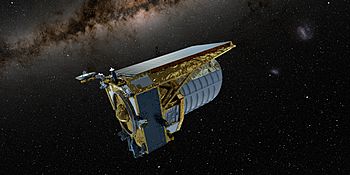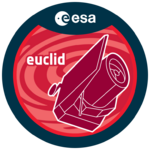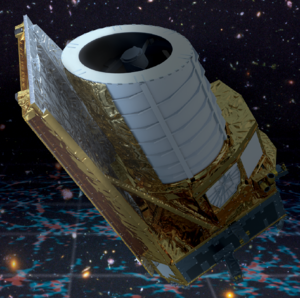Euclid (spacecraft) facts for kids

Artist's impression
|
|
| Names | Dark Universe Explorer (DUNE) Spectroscopic All Sky Cosmic Explorer (SPACE) |
|---|---|
| Mission type | Astronomy |
| Operator | ESA |
| Website | |
| Mission duration | 6 years (nominal) 2 years, 5 months and 2 days (in progress) |
| Spacecraft properties | |
| Manufacturer | Thales Alenia Space (main) Airbus Defence and Space (payload module) |
| Launch mass | 2,160 kg (4,760 lb) |
| Payload mass | 848 kg (1,870 lb) |
| Dimensions | 4.5 m × 3.1 m (15 ft × 10 ft) |
| Start of mission | |
| Launch date | 1 July 2023 15:12 UTC |
| Rocket | Falcon 9 |
| Launch site | Cape Canaveral SLC-40 |
| Contractor | SpaceX |
| Orbital parameters | |
| Reference system | Sun–Earth L2 |
| Regime | Lissajous orbit |
| Periapsis | 1,150,000 km (710,000 mi) |
| Apoapsis | 1,780,000 km (1,110,000 mi) |
| Epoch | Planned |
| Main telescope | |
| Type | Korsch telescope |
| Diameter | 1.2 m (3 ft 11 in) |
| Focal length | 24.5 m (80 ft) |
| Collecting area | 1.006 m2 (10.83 sq ft) |
| Wavelengths | From 550 nm (green) to 2 µm (near-infrared) |
| Resolution | 0.1 arcsec (visible) 0.3 arcsec (near-infrared) |
 The ESA astrophysics insignia for Euclid mission |
|
Euclid is a special space telescope built by the European Space Agency (ESA). Its main goal is to help scientists understand two mysterious things in our universe: dark energy and dark matter. These are invisible forces that make up most of the universe.
Euclid has a powerful camera that sees visible light and another instrument that sees near-infrared light. This helps it measure how far away galaxies are and how fast they are moving away from us. By studying billions of galaxies, Euclid will help us learn why the universe is expanding faster and faster.
The mission is named after Euclid, an ancient Greek mathematician famous for his work in geometry. Euclid is a medium-sized mission and part of ESA's Cosmic Vision program. It was launched successfully on July 1, 2023, aboard a Falcon 9 rocket.
Contents
Why Euclid is Important
Euclid's main job is to explore the history of the universe's expansion. It also looks at how huge structures like galaxies formed. It does this by measuring the "redshift" of galaxies. Redshift tells us how far away galaxies are and how quickly they are moving away from us. Euclid can see galaxies that are up to 10 billion years old!
How Euclid Studies the Universe
Euclid uses a few clever methods to learn about dark energy and dark matter:
Gravitational Lensing
Imagine light from a distant galaxy traveling towards us. If there's a lot of matter (like galaxies or invisible dark matter) in the way, its gravity can bend the light. This bending makes the distant galaxy look stretched or distorted. This effect is called gravitational lensing. By measuring how much galaxies are stretched, scientists can figure out how much dark matter is in different parts of the universe. This helps us understand where dark matter is hiding.
Measuring Distances with Light
Euclid also uses a method called spectroscopy. This involves splitting the light from galaxies into different colors, like a rainbow. By studying this "light fingerprint," scientists can precisely measure the redshift of galaxies. This tells them their exact distance from Earth. Knowing the distances to millions of galaxies helps scientists create a 3D map of the universe. This map shows how galaxies are spread out and how that changes over time.
All these measurements need to be super accurate. Euclid's instruments are designed to be very precise, so the data it collects is reliable.
Euclid's Design
Euclid was created from two earlier ideas for space missions. Scientists combined the best parts of both to make Euclid. The mission was formally approved by ESA in 2012.
Thales Alenia Space in Italy built the main part of the satellite. Euclid is about 4.5 meters (15 feet) long and 3.1 meters (10 feet) wide. It weighs about 2,160 kilograms (4,762 pounds).
The part of Euclid that holds the science instruments, called the payload module, was managed by Airbus Defence and Space in France. It includes a special telescope with a main mirror that is 1.2 meters (nearly 4 feet) across.
A large team of scientists, called the Euclid Consortium, helped build the instruments. This team includes scientists from 13 European countries and the United States. They will use Euclid to map the 3D positions of up to two billion galaxies. This covers more than a third of the entire sky!
Euclid's Instruments
Euclid carries two main instruments:
- VIS (Visible Imager): This camera sees light that our eyes can see. It has 600 million pixels, like a super high-resolution camera. It helps scientists measure how much galaxies are stretched by gravitational lensing.
- NISP (Near Infrared Spectrometer and Photometer): This camera sees light in the near-infrared range, which our eyes cannot see. It has 65 million pixels. NISP helps measure the distances to over a billion galaxies using different light filters. It also uses a special technique to get very precise distances for millions of galaxies. This helps scientists study patterns in how galaxies are spread out.
Spacecraft Bus
The spacecraft bus is like the "body" of the telescope. It has solar panels to get power from the Sun. It also helps keep the telescope pointed very steadily, which is crucial for clear images. The telescope is also well-insulated to keep its temperature stable.
Euclid can send huge amounts of data back to Earth every day. It uses special radio waves to send scientific information at a very fast speed. This data is sent to a ground station in Spain. Euclid can store at least 300 GB of data on board before sending it down.
The service module (SVM) holds many important systems that help the spacecraft work. These include systems for communication, controlling its position, managing data, and providing power.
Key Moments in Euclid's Journey
- 2013: NASA joined the mission, agreeing to provide 20 detectors for the near-infrared instrument. They also added 40 American scientists to the Euclid team.
- 2015: Euclid passed an important design review. This meant that many technical designs were complete, and key parts had been built and tested.
- 2018: Euclid passed its final design review. This allowed the team to start putting the spacecraft together.
- 2020: Both science instruments (VIS and NISP) were delivered to Airbus in France to be installed on the spacecraft.
- 2022: The original plan was to launch Euclid on a Russian Soyuz rocket. However, due to world events, ESA changed the launch vehicle to a SpaceX Falcon 9.
- 2023: Euclid successfully launched on July 1, 2023.
Euclid's Mission and Data
After about 30 days of travel, Euclid reached its special orbit around a point called L2. This spot is about 1 million kilometers (620,000 miles) from Earth, where it can have a clear view of space without being blocked by Earth or the Moon.
During its mission, which will last at least six years, Euclid will observe about one-third of the entire sky. It will focus on parts of the sky away from our own Milky Way galaxy. It will also look at three "deep fields" – smaller areas that it will visit often. These deep fields help calibrate the telescope and study the most distant galaxies and quasars.
Euclid will observe about 10 billion objects in space. Out of these, about 1 billion will be used for weak lensing studies, which means measuring how their light is bent by gravity. This will be 50 times more accurate than what ground telescopes can do today. Euclid will also measure the distances to at least 30 million objects to study how galaxies are grouped together.
The huge amount of data Euclid collects will be analyzed by over 1,200 scientists from 15 countries. This team also helped build Euclid's instruments and set up the systems to process all the data. Nine special data centers will process more than 10 petabytes of raw images. That's a massive amount of information!
The data from Euclid will be useful for many other astronomy projects, not just for studying dark energy and dark matter. It will provide valuable information for other powerful telescopes like the James Webb Space Telescope and future observatories.
See also
 In Spanish: Euclid (nave espacial) para niños
In Spanish: Euclid (nave espacial) para niños


